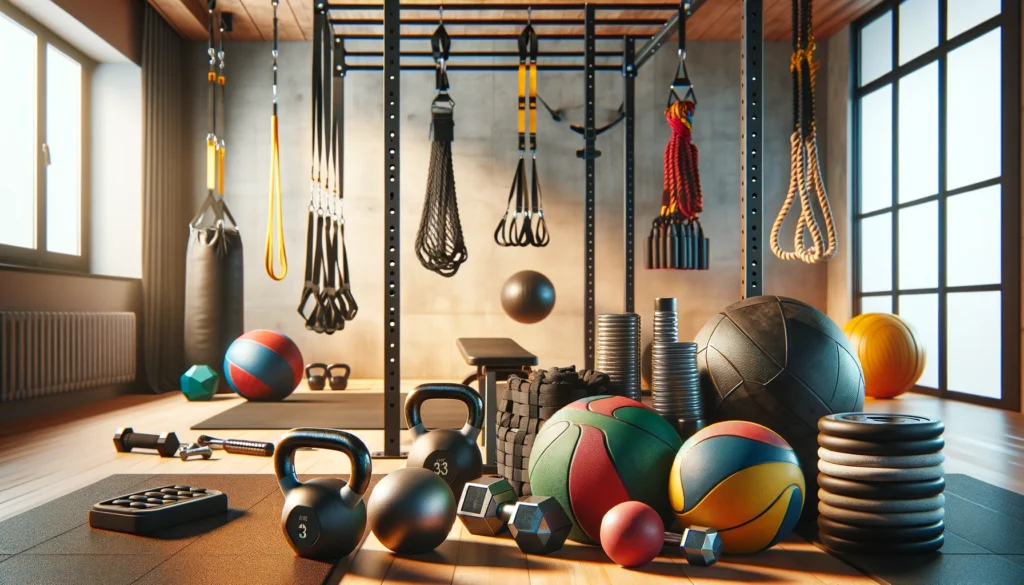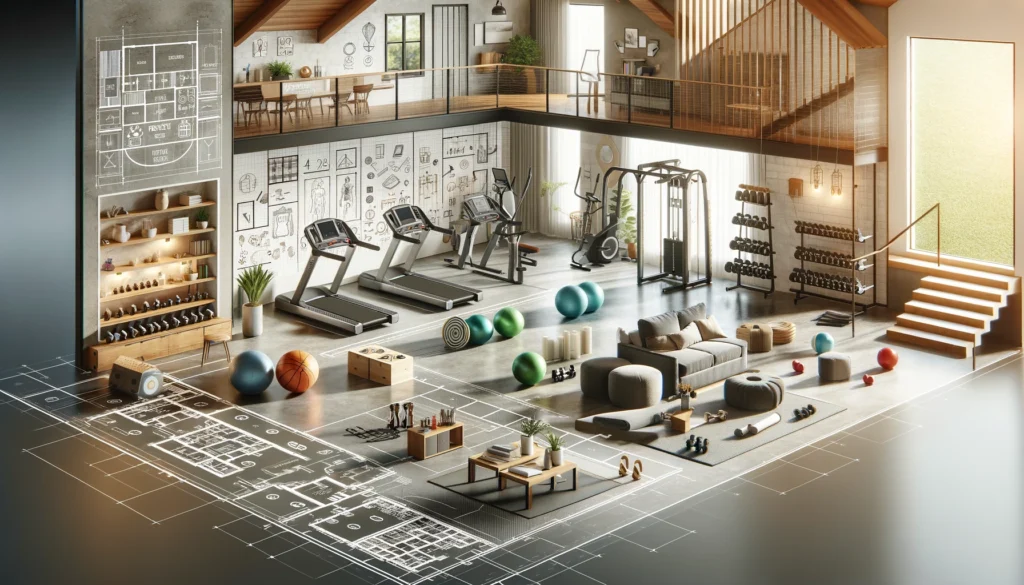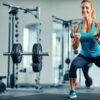The Rise of Home Gyms
Remember when home gyms were mainly those awkward contraptions tucked in basements and mostly gathering dust? Those days are long gone. Having a space to work out at home has skyrocketed in popularity, becoming an appealing reality for a wide range of fitness enthusiasts.
Why the trend? Several factors fuel this shift towards home fitness havens:
- Convenience: Rolling out of bed and having instant access to workout equipment crushes a major barrier to exercise. You’re saving time and energy, a significant plus in our always-on hectic lives.
- Privacy & Comfort: Worried about gymtimidation? Prefer training sessions without onlookers? A home gym allows you to let loose and personalize your workouts exactly how you like.
- Flexibility with the Unexpected: From bad weather to unpredictable work schedules, having a home gym removes the need to constantly adapt around unreliable gym availability.
- Long-Term Investment: With home gym prices becoming increasingly competitive, and monthly gym memberships adding up, the upfront cost is often justified in the long run.
Of course, there are considerations like space constraints and initial outlay, but for many, having a designated fitness sanctuary within their own four walls unlocks a level of workout consistency they were previously struggling to achieve.
 Best Home Gym Equipment for Strength Training
Best Home Gym Equipment for Strength Training
When it comes to building muscle, increasing strength, and developing powerful athleticism, nothing beats the effectiveness of weightlifting. Investing in quality gear is crucial, especially when aiming for more advanced techniques.
Selecting the Right Weightlifting Equipment
A robust strength training toolkit generally centers around these:
- Barbell & Plates: An Olympic barbell is your best long-term investment – durable, with standardized sizing to fit your chosen plates. Start with a modest range of weight plate sizes for gradual progressions as you get stronger.
- Power Rack or Squat Stand: A safe, adaptable base for barbell work (think squats, bench presses, deadlifts, etc.). Racks with built-in pull-up bars add even more versatility for a home gym.
Here’s where your space (and budget!) matter: Power racks offer maximum stability, safety features, and room to grow. A squat stand saves space while fulfilling barbell needs at a generally lower cost.
Advanced Free Weights
As your strength journey progresses, you might want to expand your toolbox with:
- Dumbbells: Adjustable dumbbells save space and allow for rapid weight switching during workouts. Consider options like Bowflex adjustable dumbbells or PowerBlocks for greater efficiency.
- Kettlebells: Incredibly versatile for dynamic strength training, kettlebells add an element of explosiveness and functional movement to your workouts.
High-Performance Resistance Machines
- Functional Trainers: Machines with adaptable cable pulleys offer endless strength training variations that closely mimic free-weight movements but in a more controlled environment.
- Specialty Strength Machines: If you have space (and budget), machines offering a targeted focus on specific muscle groups (leg press, hack squat, etc.) can further elevate your home gym.
Important Consideration: When choosing heavier equipment, it’s wise to factor in safe maneuvering and floor protection in your home gym space.
Cardiovascular Machines for a Comprehensive Workout
Cardiovascular exercise burns calories, improves heart health, and boosts endurance. Integrating an element of cardio into your home gym sessions provides a fantastic well-rounded training approach. Let’s look at a few excellent options:
Treadmills with Advanced Features
Gone are the days of boring, monotonous treadmill slogs. Modern machines offer engaging features:
- Interactive Workouts: Treadmills like the Peloton Tread or NordicTrack models utilize subscription-based platforms with live and on-demand trainer-led classes, scenic runs, and real-time progress tracking.
- Incline & Speed Programs: Built-in workout programs with elevation and speed changes amp up the intensity, challenging you like no casual stroll ever could.
- Heart Rate Monitoring: Chest straps or wrist-based sensors offer accurate workout intensity tracking, optimizing your calorie burn and fitness benefits.
High-Intensity Interval Training (HIIT) Equipment
Perfect for blasting calories in shorter bursts, these machines amp up the challenge:
- Assault Bikes: Fan-based designs provide progressive resistance – the harder you pedal, the tougher it gets! These brutal and incredibly effective bikes push your cardiovascular system to its limits.
- Curved Treadmills: Self-powered by your own stride, a curved treadmill lets you dictate the pace and offers high-intensity intervals while enhancing running mechanics.
Rowing Machines & Ellipticals for Endurance Training
- Rowing Machines: Engaging your entire body with each pull, rowing machines such as the popular Concept2 deliver low-impact yet incredibly effective cardio, boosting muscle endurance and improving core strength.
- Ellipticals: These offer a smoother, joint-friendly option compared to running. Look for adjustable resistance and stride length features for customized difficulty.
Tip: Combining diverse cardio options keeps your workouts exciting! A treadmill on some days, rowing on others, and throwing in an occasional HIIT session is a great way to avoid boredom and push past any training plateaus.
Functional Training Gear
Taking your workouts beyond basic weightlifting opens the door to agility, explosive power, and increased resistance to injury. These versatile options pack a punch, even within limited home gym spaces.
Kettlebells and Medicine Balls
Don’t be fooled by their simplicity. These dynamic tools excel at developing muscular endurance and power:
- Kettlebell Swings: This ballistic exercise strengthens the posterior chain, improving your core stability, jumping ability, and grip strength.
- Medicine Ball Slams: Explosive full-body movements like ball slams unleash power while adding a serious cardio element to your sessions.
Suspension Training Systems
Utilizing gravity and your own body weight, these setups deliver scalable challenges for all fitness levels:
- TRX / Gymnastic Rings: Offering countless exercise variations targeting flexibility, strength, and core power. Suspension systems easily attach to doorframes or secure ceiling mounts.
Battle Ropes and Sandbags
When pushing beyond limits sounds appealing, try these unforgiving (yet incredibly satisfying) implements:
- Battle Rope Waves: Intense cardio combined with shoulder and core work. With options in weighted lengths, you can find the right level of brutal.
- Sandbag Training: Lifting, carrying, and slamming sandbags engages muscles in unique ways with an unstable load, simulating activities outside the gym.
Important Consideration: Functional movements often demand mastering good form to reduce injury risk. Start with tutorials from credible sources to ensure maximum benefit:
- Onnit Academy offers fantastic resources for kettlebell technique: https://www.onnit.com/academy/
- Detailed TRX exercise breakdowns can be found on their website: https://www.trxtraining.com/
Technology Integration in Home Gyms
Advances in fitness technology bring personalized workouts, data-driven feedback, and gamified exercise straight to your home. Let’s look at some game-changing developments:
Smart Fitness Equipment
- Connected Mirrors: Think full-length interactive screens seamlessly blending on-demand classes led by expert trainers with AI-powered form correction. Options like the Tonal or Tempo Studio revolutionize strength training routines, making gym-quality coaching accessible right from your living room.
- Smart Cardio Machines: Peloton is the prime example, offering live studio classes with leaderboards for that competitive edge, even from afar. Many of these smart machines provide feedback on metrics like cadence, heart rate, and speed, helping you fine-tune your training.
Virtual Training Apps and Platforms
Subscription-based services offer incredible flexibility for building diverse home workouts without investing in costly equipment:
- Apple Fitness+: Utilizing your iPhone, iPad, or Apple TV, access on-demand workouts designed for all fitness levels. Choose from strength, HIIT, dance, yoga, and more.
- Nike Training Club: A widely utilized free app providing guided workouts from strength training to yoga with different intensity levels. Perfect for no-equipment exercises!
- Fitbit Premium: With guided workout sessions, data tracking, and tailored fitness insights, Fitbit’s premium platform goes beyond basic step counting.
Wearable Fitness Trackers
Smartwatches and fitness trackers gather real-time workout data, helping you see trends and optimize training. Here’s the info they unlock:
- Heart Rate: Track workout intensity and ensure you’re in the ideal training zone for your goals (fat-burning, endurance, etc.).
- Sleep Monitoring: See how rest affects your training and identify sleep patterns to improve recovery.
- Workout Summaries: Monitor calories burned, distances covered, and active minutes – valuable feedback for measuring progress.
Warning: It’s easy to get sucked into data overload. Stay focused on your health and fitness goals over purely chasing specific metrics.
 Space-Saving Solutions for Home Gyms
Space-Saving Solutions for Home Gyms
Not everyone has an entire room to dedicate to fitness. Thankfully, clever ideas exist to maximize even the most limited space, proving a lack of square footage isn’t a barrier to success!
Foldable and Compact Equipment
- Collapsible Cardio Machines: Treadmills and ellipticals with foldable designs conveniently slide or tuck away when not in use, creating more room for other workouts.
- Portable Strength Equipment: Resistance bands, stackable dumbbells, and a foldable workout bench take up minimal space, offering a surprising amount of strength-training versatility.
Multi-purpose Fitness Machines
These space-savers consolidate the functions of several pieces of equipment into one:
- Compact Home Gyms: Combining weight stacks, pulleys, and other attachments, they serve as a multi-station unit ideal for smaller home gyms. Consider options like the Bowflex Blaze for resistance training variety.
- Wall-Mounted Pull-Up / Dip Bars: When floor space is limited, sturdy wall-mounted systems take up minimal room while offering crucial bodyweight exercise functionality.
Creative Storage Options
- Under-Bed Storage: Rolling bins are perfect for stowing weights, bands, yoga mats, and smaller fitness gear without losing precious floor space.
- Vertical Wall Racking: Keep resistance bands, jump ropes, and other training tools tidy and accessible by utilizing vertical wall storage.
- Dual-Purpose Furniture: A coffee table with built-in storage for kettlebells or a bench that doubles as extra seating – think multi-function for every item!
Safety and Maintenance of Home Gym Equipment
Safety and care are essential for protecting your investment in your home gym and yourself! Take these proactive steps:
Regular Maintenance Tips
- Inspect for Wear & Tear: Check equipment before each use to identify cracks, worn components, or loose bolts. Fix issues before they compromise your safety.
- Proper Cleaning: Wipe down equipment after use to prevent sweat buildup and preserve materials. Regularly sanitize surfaces and handles to keep things hygienic.
- Follow Assembly Instructions: Don’t skip this step, even for seemingly simple equipment. Incorrect assembly can compromise safety and performance.
Safety Features to Look for
- Stable Bases: Equipment like power racks should be bolted down or designed with robust bases and weights to avoid tipping during heavy lifts.
- Locking Mechanisms: Dumbbells, barbells, and adjustable benches require secure locking mechanisms to prevent weights or positions from shifting unexpectedly.
Ensuring Equipment Longevity
- Read Warranty Information: Understand coverage terms and any limitations to get the most out of equipment warranties.
- Environment: Extreme heat, humidity, or direct sunlight can degrade materials. Place equipment in suitable indoor spaces for optimal conditions.
- Weight Limitations: Follow product manuals regarding maximum weight capacities to avoid breakage and strain on the equipment.
Designing Your Home Gym
Building your perfect home gym involves blending space-efficient layouts with the equipment that motivates you the most. Let’s go through some core principles:
Planning Your Space for the Best Home Gym Equipment
- Measurements: Know the exact dimensions of your space and large equipment pieces to avoid ordering bulky gear that simply won’t fit.
- Ceiling Height: If power racks or a pull-up bar are on the list, be mindful of overhead clearance. Consider basement spaces if this is crucial.
- Traffic Flow: Create ample moving space around equipment so workouts aren’t hampered by constantly needing to dodge things.
- Flooring: Look into gym flooring mats or interlocking rubber tiles. They protect your flooring, reduce noise, and provide safe workout surfaces.
Essential Equipment for Beginners to Advanced Users
Consider your experience level and goals for smart equipment choices:
- Beginners: Dumbbells, a basic bench, resistance bands, and a stability ball provide an excellent starting point for learning foundational exercises.
- Intermediate: Kettlebells, power racks, and a basic cardio machine offer progression paths, greater challenges, and diversity to keep workouts engaging.
- Advanced: Advanced options like cable machines, trap bars, and specialized gear depend on your sport-specific goals, providing greater focus and niche challenges.
Aesthetic and Functional Design Considerations
- Color Scheme: Choose motivating colors and consider if neutrals or bold vibes fit your workout persona best. Think about paint or accents if applicable.
- Lighting: Good lighting, natural or supplemental, boost energy levels, creates a more inviting space, and helps with form checks when training.
- Music & Audio: A wireless speaker for your workout jams or podcasts adds to the ambience. Headphones are excellent for a singular focus during sessions.
- Ventilation: Good airflow is crucial. Consider ceiling fans, windows, or portable air purifiers, especially in smaller spaces.
- Personalization: Motivational posters, workout calendars, or progress photos on a corkboard, add personal touches that energize you each time you walk in.
 Home Gym Equipment for Specific Fitness Goals
Home Gym Equipment for Specific Fitness Goals
The beauty of a home gym is the personalization. Building your set-up around your unique goals maximizes motivation and results. Here’s what to emphasize depending on your primary focus:
Equipment for Weight Loss
- Cardio Machines: Prioritize treadmills, ellipticals, stationary bikes, or rowers that promote sustained fat-burning cardio sessions.
- HIIT Tools: Assault bikes, battle ropes, or medicine balls allow for short, intense intervals – excellent for metabolic boosts.
- Bodyweight & Strength: Kettlebells, dumbbells, suspension systems, and resistance bands support circuit-style, full-body strength workouts that also help you burn significant calories.
Gear for Muscle Building
- Strength Foundations: Invest in a solid power rack or squat stand, with a quality barbell and weight plates offering the most long-term potential for strength gains.
- Progression Focus: Dumbbells, cable machines, and other resistance-based equipment help target muscle groups specifically for hypertrophic (muscle-building) training.
- Advanced Muscle Growth: Explore advanced lifting tools like specialty bars, Olympic rings, or heavy lifting straps when maximum power and mass become your objective.
Tools for Flexibility and Recovery
- Foam rollers & Massage Balls: Release tight muscles and enhance mobility. Look for different varieties of these self-myofascial release tools for deeper targeted massage.
- Yoga Mat & Blocks: Ideal for dedicated stretching sessions, aiding flexibility, promoting balance, and aiding post-workout recovery.
- Recovery Equipment: Consider options like Theragun massage tools or vibrating platforms for muscle soreness relief and enhanced recovery time.
Important: Prioritize form and progression. Chasing heavier weights with sloppy technique defeats the purpose, and increases injury risk. Start lighter, learn good form, and advance gradually!
Challenges and Solutions in Home Training
Even with the utmost dedication, home workouts come with unique challenges. Recognizing those challenges, however, lays the path to finding impactful solutions!
Overcoming Motivation Hurdles
The absence of a bustling gym atmosphere or external accountability can create motivation dips. Here’s how to combat that:
- Set Realistic Goals: Starting too ambitious can be demoralizing. Focus on manageable milestones that build confidence and momentum.
- Schedule it like an Appointment: Prioritize workouts in your calendar. A visual cue solidifies their importance and provides less room to make excuses.
- Find Workout Buddies: Even if virtually, having someone to hold you accountable (and vice versa) significantly impacts consistency.
- Variety: Prevent boredom! Switch up workouts (using that core stability LSI list), try new fitness formats, or introduce outdoor training into your routine.
- Track Progress: Nothing is more motivating than seeing tangible progress. Whether it’s more reps, better form, or increased intensity, keep a log!
Dealing with Limited Space
Space restrictions are a common challenge, but not an insurmountable one. Optimize your layout:
- Versatile Equipment: Select gear with a small footprint or multiple functions (resistance bands, dumbbells, TRX).
- Wall-Mounted Options: Consider racks that fold against the wall when not in use, pull-up bars that mount in doorways, etc.
- Use Your Furniture: Sturdy chairs and benches can double as platforms for exercises.
- Vertical Storage: Use hooks and organizers to hang exercise gear, freeing up floor space.
Community and Support for Home Gym Users
Even home workouts don’t need to be an isolating endeavor! Leaning on the support and motivation of others can transform and supercharge your journey.
Online Communities and Forums
The internet is your gateway to vibrant fitness communities catering to every niche. Engage and explore options like:
- Social Media Groups: From subreddits focusing on specific programs or equipment to general home gym enthusiasm groups, connecting with like-minded individuals is effortless.
- Equipment or Brand-Specific Communities: Many fitness equipment brands build vibrant forums where users share tips, workout ideas, and support each other.
- Niche Platforms: Discover workout groups geared toward your specific goals (weight loss, athleticism, strength building) for concentrated advice and accountability.
 Virtual Personal Training
Virtual Personal Training
If personalized guidance is a priority, virtual training may be a great fit. Advantages include:
- Professional Programming: Receive tailored workout plans and form adjustments.
- Accountability and Motivation: Regular check-ins and feedback keep you on track.
- Convenience: Exercise on your schedule from the comfort of your home.
- Resources: Many virtual trainers offer nutritional guidance and additional support beyond workout sessions.
Group Workouts and Challenges
The competitive spirit and camaraderie of group workouts can spill over to the virtual world:
- Social Media Challenges: Participate in hashtag-driven fitness challenges on Instagram, TikTok, etc. These are often time-bound and create a sense of shared purpose.
- App-Based Workouts: Explore apps with live workout classes, allowing you to train with others (and instructors) in real-time.
- Create Your Own Challenge: Get a few friends with similar goals, design a challenge structure of your own, and track progress together for friendly competition.
Benefits of Building a Community
Whether through online connections or a small workout crew at home, community brings multiple benefits:
- Support and Motivation: Lean on others during dips in motivation. Sharing goals and celebrating wins increases commitment.
- Idea Exchange: Inspiration can be found everywhere! Discover new workouts, exercises, or nutritional tips from a connected community.
- Fun and Challenge: Friendly competition with a supportive group can often get you to push past your perceived limits.
The Future of Home Gyms
Home gyms have evolved greatly in recent years, and the innovation wave shows no signs of slowing down. Let’s discuss some of the trends shaping this dynamic space for best home gym equipment:
Emerging Trends in Home Fitness
- Smart Equipment: Think exercise bikes with integrated touchscreens, mirrors that provide real-time form correction, and AI-powered weightlifting machines that adapt resistance.
- Expanded Virtual Training: Beyond live virtual classes, expect increasingly immersive experiences, integrating virtual instructors, training simulations, and gamification elements.
- Focus on Recovery: As awareness grows of recovery’s role in progress, home gym equipment focuses on muscle therapy (percussive therapy devices, vibrating foam rollers), and mental recovery elements (guided meditations, etc.).
The Role of AI and Machine Learning
The integration of Artificial Intelligence promises to unlock significant enhancements in home fitness:
- Personalized Training Programs: AI algorithms can analyze your form, workout data, and goals to create workout programs tailored like never before.
- Virtual Coaching: AI can increasingly analyze movement patterns for better real-time form feedback, similar to (someday possibly better) than an in-person trainer.
- Data-Driven Progress: Advanced workout tracking will go beyond counting sets and reps to provide granular analysis of improvement over time.
Sustainable and Eco-Friendly Equipment
With growing emphasis on environmental factors, the fitness industry also starts addressing concerns:
- Recycled Materials: Equipment brands will emphasize incorporating recycled components and sustainable production processes.
- Reduced Energy Consumption: Expect a push toward energy-efficient smart workout equipment.
- Minimalist Design: There’s a shift towards focusing on high-quality, durable essentials instead of bulky machines with extensive features.
Important Notice: Technological advancements bring potential, but don’t lose sight of your foundation. Progress is still primarily driven by consistent workouts and sound nutrition, no matter how tech-enabled your home gym may become.
Budgeting for Your Home Gym
The beauty of home gyms is the flexibility – you can create a fitness space that aligns with your needs and your wallet. Here’s how to make those budget dollars work as hard as you do:
Cost-Effective Equipment Choices
You don’t need to break the bank to achieve great results. Consider prioritizing these bang-for-your-buck essentials:
- Resistance Bands: Incredibly versatile for a wide range of exercises targeting every muscle group.
- Dumbbells: A set of adjustable dumbbells saves space and replaces an entire rack of fixed weights.
- Kettlebells: Combine power, cardio, and core work in a compact package. Great for dynamic, athletic movement patterns.
- Stability Ball: Improves balance, core strength, and can be incorporated into multiple exercises for both strength and flexibility.
- Used Equipment: Scan local resale listings for high-quality used gear at a fraction of the cost of buying new.
Financing and Subscription Models
Spreading out costs can ease the impact of larger purchases. Explore:
- Buy Now, Pay Later Options: Some retailers offer these, allowing you to break up the cost of fitness equipment (like a treadmill) into manageable installments.
- Subscription Models: Emerging brands offer connected fitness gear paired with a monthly subscription to classes and programming. This can be cost-effective versus a gym membership when combined with some foundational home gym items.
Balancing Quality and Affordability
While being budget-conscious is wise, beware of cheap, flimsy equipment. This is an area where it pays to invest a bit more.
- Prioritize Safety: Look for sturdy construction and smooth adjustments in any equipment involving significant weights or motion.
- Do Your Research: Read reviews and compare features between brands before buying. Don’t overpay for gimmicks, but don’t skimp on crucial elements.
- Start Small, Upgrade Gradually: It’s wiser to start with quality essentials (maybe those dumbbells and a sturdy bench) and add over time as your budget allows.
The Best Home Gym Equipment Checklist
Building your dream home gym can be a gradual and exciting process! This checklist ensures you cover the critical points, whether starting with the basics or adding to an existing setup.
Essential Equipment List
- Resistance Bands
- Adjustable Dumbbells
- Stability Ball
- Workout Mat
- Jump Rope (optional, but highly portable and effective)
Advanced Tools for Experienced Users
- Exercise Bench (adjustable preferable)
- Pull-Up Bar
- Kettlebells
- Cardio Machine (if space and budget allow – stationary bike, rower, etc.)
Maintenance and Safety Essentials
- Equipment Cleaning Supplies: For sanitizing gear, especially those shared among multiple users.
- Floor Protection: If necessary, prevent damage to flooring with padding or thicker mats under heavier equipment.
- Form Check Resources: Whether it’s YouTube instructional videos, hiring a trainer for a few sessions, or even a well-positioned mirror, having some way to self-assess your exercise form minimizes injury risk.
FAQs
- What Best Home Gym Equipment Is Essential for a Beginner? Focus on a few versatile staples: resistance bands, adjustable dumbbells, a stability ball, a workout mat, and a skipping rope for optional cardio bursts.
- How Can I Maximize Space in a Small Home Gym? Select equipment with a minimal footprint (resistance bands, TRX suspension trainers), wall-mounted options (pull-up bars), items serving multiple purposes (adjustable bench), and prioritize vertical storage when gear’s not in use.
- What Are Some Advanced Techniques for Home Gym Workouts? Use methods like supersets (multiple exercises back-to-back), drop sets (decreasing weight to failure), and progressive overload (gradually increasing weight, reps, or sets) to challenge your muscles and prevent plateaus.
- How Often Should I Upgrade My Home Gym Equipment? Upgrades primarily hinge on your progress and shifting goals. Adding resistance as you grow stronger, or expanding equipment if you find a new focus with exercise (Crossfit accessories, Olympic lifting gear, etc.) dictates upgrades more than any set timeline.
- Can these Best Home Gym Equipment Guidance Help with Specific Health Issues? Absolutely! Consult a physical therapist or medical professional to understand the best exercises for your condition. A home gym allows you to address those needs consistently and privately with appropriate supervision.
- How Do I Stay Motivated to Use My Home Gym Regularly? Here are some strategies: make your workouts fun (experiment with programs, music selection), track progress (photos, measurements), find an accountability buddy, and set realistic goals that keep you feeling successful.
- Where Can I Explore Exercises Specifically for Core Stability? Look for workouts focusing on abdominal isometric holds, plank variations, anti-extension exercises, and stability ball movements. These will build deep core power alongside visible ab sculpting.
Conclusion
Summing Up the Home Gym Journey
Whether aiming for peak performance or improving overall health, having your own fitness space is incredibly empowering. It promotes consistency and offers endless possibilities for exploring fitness in a way that feels right for you.
Encouraging Consistency and Progress
Remember, the perfect home gym isn’t an end goal, but a tool to achieve your greater fitness aims. Celebrate every small victory, adjust with feedback from your body, and remember that showing up to train is half the battle.


 Best Home Gym Equipment for Strength Training
Best Home Gym Equipment for Strength Training Space-Saving Solutions for Home Gyms
Space-Saving Solutions for Home Gyms Home Gym Equipment for Specific Fitness Goals
Home Gym Equipment for Specific Fitness Goals Virtual Personal Training
Virtual Personal Training





